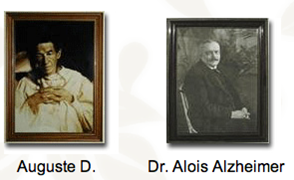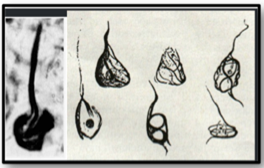1. SENILE DEMENTIA
The Egyptians are accredited with making an association between cognitive decline and old age about 4000 years ago. The clinical description of dementia came later on in the 18th century by the French physician Phillippe Pinel, known as the father of modern psychiatry. His student Jean Etienne Esquirol introduced the concept of senile dementia in the 19th century. The clinic-pathological features of senile dementia revealed an association between a reduction in brain weight and atrophy. For many hardening of the arteries was the cause of senile dementia. In the late 19th century senile plaques were described by Blocq and Marinesco in epileptic brains. The plaques remained to be described in dementia brains.
Source: Schneider JA et al Neuropathological basis of Alzheimer ‘s disease and Alzheimer disease diagnosis: In Alzheimer’s disease-Modernizing Concept Biological Diagnosis and Therapy (Hampel H, Carrillo M eds.) Adv Biol Psychiatry Basel Karger 2012 vol 28 pp 49-70.
2. DISCOVERY OF ALZHEIMER’S DISEASE
1901 Alois Alzheimer was an assistant physician, at the psychiatric clinic in Frankfurt when he met Auguste Deter. At 51 years of age she had developed memory problems, was confused, thought her husband was unfaithful, had difficulties in speaking and understanding what was being said to her. Alzheimer was intrigued with this patient and continued his interviews.

1906 Auguste D died. Alzheimer had been recruited by Emil Kraeplin, the founder of modern psychiatry to join his department in Munich. He received permission to perform an autopsy on Auguste’s brain. Alzheimer took advantage newly developed silver stains to examine her brain tissue. He noted shrinkage of the brain in particular the cortex, the outer layer involved in memory thinking judgment and speech. He noted that the brain contained numerous senile plaques. Numerous brain cells were dead. The novelty of his observations was the presence of brain cells containing thick, strongly stained twisted fibrils otherwise known as neurofibrillary tangles.
On November 3, 1906, at the 37th annual conference of German psychiatrists, in Tübingen, Germany, Alzheimer presented a lecture entitled “On the peculiar disease process of the cerebral cortex”. However his findings received little interest from the attendees, which included prominent investigators. Alzheimer subsequently published his observations. He described Auguste D’s disorder as being unusual and rare. In view of her age of onset Alzheimer proposed that this unusual disorder was presenile dementia. This concept remained for about 50 years after Alzheimer’s death in 1915.

Drawings, by Alzheimer, depict fibrils twisting around the nuclei from his first patient, Auguste D
1910 Naming Alzheimer Disease
Dr. Emil Kraepelin introduced the term Alzheimer ‘s disease in the 8th edition of his Handbook of Psychiatry. He described Alzheimer’s disease as a rapidly progressive, young onset, dementia with distinct pathology,that was separable from senile dementia. Senile dementia was considered as normal part of aging and was attributed to cerebrovascular disease.
Sources:
Grand J and Feldman H Historical concepts of Alzheimer disease and dementia In Atlas of Alzheimer’s disease Howard Feldman 2007
John R. Hodges Alzheimer’s centennial legacy: origins, landmarks and the current status of knowledge concerning cognitive aspects
Brain Volume 129, Pp. 2811-2822 (2006)
3. DORMANT PERIOD 1910-1970

Alzheimer’s disease received little attention from 1910 until the 1970s. However the first publication to have Alzheimer’s disease in its title was by Corsellis JAN, Brierley JB. An unusual type of pre-senile dementia (atypical Alzheimer’s disease with amyloid vascular change). Brain 1954;77:571-87. This was followed by a 1964 publication by Kidd M. Alzheimer’s disease: an electron microscopical study. Brain 1964;87:307-20.
During this time span Alzheimer’s disease was defined as a “presenile dementia” – onset before age 65 – and considered to be an interesting but rare disorder. Senile dementia continued to be viewed as the common form of dementia, which was attributed to cerebrovascular disease and the normal aging.
4. Notable Events in the 1970s
A) Sir Martin Roth noted that even though plaques are present in the brains in the elderly their number appeared to correlate with the with the severity of dementia
B) Dr. Robert Katzman published his landmark 1976 editorial The Prevalence and Malignancy of Alzheimer’s Disease, in Archives of Neurology calling the disorder a “major killer.”
In this editorial he identified Alzheimer’s disease as most common cause of dementia and major public health challenge. Notably he declared that presenile dementia and senile dementia were the same condition and that neither was a part of normal aging. He also predicted that would be huge an epidemic that should be a wake call for immediate action. Katzman is highly recognized as an Alzheimer’s activist who redefined the disorder as the most frequent progressive dementia during aging. He also made it a personal goal that everyone should be aware of the Alzheimer’s disease if it were to be understood and defeated. He was a strong advocate for increased funding for research in the disease and, in part due to Katzman’s influence, federal funding in Alzheimer’s research grew from $5 million in 1980 to over $300 million by 1996.
C) Significant Organizations established
i. National institute on Aging at NIH This institute placed Alzheimer’s disease as its top priority
ii. The Alzheimer’s Disease and Related Disorders Association (nowadays this is the Alzheimer’s Association) was founded as a private organization by Jerome Stone together with concerned families then. Chapters of this Chicago based organization spread nationwide. Its main goals are raise awareness about Alzheimer’s disease, and funding for research support
D) Neurotransmitter deficit associated with Alzheimer’s disease
There was a very significant scientific break through with the discovery that acetylcholine a neurotransmitter linked to memory capacities was markedly decreased in the brains of Alzheimer’s patients. This discovery eventually became the basis for the development of acetylcholinesterase inhibitors the first class of drugs approved by the FDA for the treatment of Alzheimer’s disease.
Sources:
http://brain.oxfordjournals.org/content/129/11/2811.full
http://www.alz.org/research/science/major_milestones_in_alzheimers.asp
John Growdon Forward In The Handbook of Alzheimer’s disease and Other Dementias edited by Andrew Budson and Neil Kowall 2011 Wiley Blackwell
5. 1980s- to present: WAKE UP CALL ALZHEIMER’S DISEASE MAJOR EPIDEMIC ON THE HORIZON
In the space of 70 years Alzheimer’s disease was propelled from a rare type of presenile dementia to a major health threat as it was now being viewed as the most common type of dementia affecting older persons not only those under 65. Our understanding of this complicated neurodegenerative disorder has been enhanced through dedicated researchers, clinicians and advocates. Research has led to the understanding of Alzheimer’s brain, the hallmark lesions and genes. Diagnostic guidelines have provided means to early detection. Keeping Alzheimer’s disease in the public eye has led to awareness support for caregivers, and the generation of funding and resources.
Conventional View of Alzheimer’s disease
- Alzheimer’s disease is the most common form of dementia, a serious degenerative brain disorder that impacts daily living through memory loss and cognitive changes.
- Clinicians and researchers have identified six cognitive domains that are commonly disturbed in patients suffering from AD: memory, executive functioning, language, visuospatial functioning, attention and affect (to the experience of feeling or emotion)
- Symptoms of Alzheimer’s disease usually develop slowly and gradually worsen over time, progressing from mild forgetfulness to widespread brain impairment.
- Associated with several neuropathological markers the most common are amyloid plaques (outside brain cells) and neurofibrillary tangles (inside brain cells) which progress throughout the brain
- Life span after diagnosis is 10-20 years
- One in ten people over 65 years of age, and over half of those over 85 have Alzheimer’s disease
